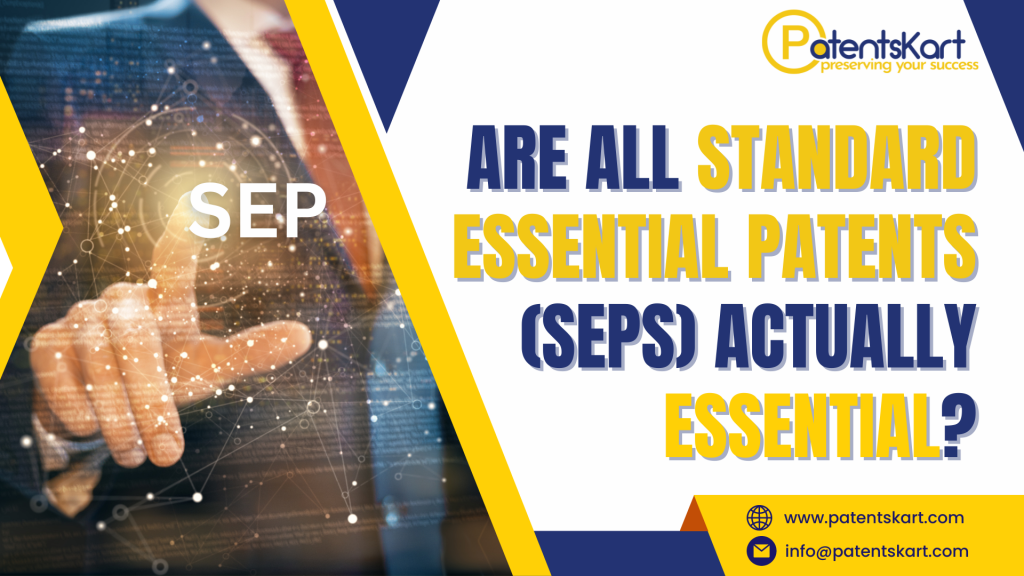Patents deemed necessary for enacting a specific industry standard are known as Standard Essential Patents (SEPs). These patents are essential for maintaining compatibility and interoperability between various gadgets and technology. However, identifying a patent as essential is not always simple. Are all Standard important Patents genuinely important, as this blog will examine? We will look at the difficulties in assessing a patent’s essentiality and talk about the repercussions of misidentifying or broadening the definition of SEPs.
Patents that are Standard Essential:
Before exploring SEPs’ importance, it is crucial to comprehend how they contribute to standardization. To guarantee that distinct goods from various manufacturers can function together successfully, industry standards are established. SEPs cover the technologies required to implement a particular standard. These patents, which frequently go to innovators who have made major contributions to the standard’s development, are essential for promoting widespread adoption and interoperability.
Problems in Establishing Essentiality:
Patent essentiality evaluation is a difficult and frequently arbitrary process. Technical assessments are used to determine whether patents are crucial for putting a standard into practice by standard-setting organizations (SSOs) and patent owners. However, for a variety of reasons, these judgments can be difficult:
Complexity of Standards: Contemporary standards, particularly in industries with a focus on technology, are frequently sophisticated and multifaceted. A thorough understanding of the technical specifics and the specific functionalities covered by the standard is necessary to decide whether patents are actually crucial.
Multiple patents may occasionally cover identical or converging technology that is involved with a standard. It can be difficult to distinguish between essential and non-essential patents in this situation since the lines between them may be hazy and open to interpretation.
Standards are constantly changing to reflect changes in technology and consumer demands. As a result, when the standard develops, the necessity of a patent may alter. As new technologies are developed, what was once thought to be necessary may become less important or even obsolete.
Differences in Interpretation: Different parties involved may have different ideas about what makes a patent essential. The identification procedure can become even more challenging as a result of arguments and conflicts regarding the use of particular patents.
Consequences of incorrectly classifying or overextending SEPs
For the industry, patent owners, and users of technology, a wrong definition of SEPs or an overly broad definition might have serious consequences. Some possible effects include:
An erroneous inclusion of non-essential patents in the list of SEPs may provide a barrier to competition. Companies may experience difficulties putting the standard into practice and be vulnerable to unjust licensing conditions or legal action, which would impede innovation and competition.
Impact on License and Royalties: Extending the definition of SEPs beyond what is necessary may result in more patents requiring licenses. Implementers may incur greater royalties and license fees as a result, which could limit their capacity to adapt and compete in the market.
Legal and Regulatory Challenges: Patent holders who incorrectly classify SEPs may face legal challenges and disagreements when they attempt to enforce their non-essential patent rights. This can cause a backlog of cases for courts and regulatory agencies that could have been avoided with a more precise assessment of essentiality.
Impact on Standardization Processes: Incorrect SEP identification can damage trust in the standardization process as a whole. Stakeholders may have concerns about the transparency and efficiency of SSOs in assuring the inclusion of only necessary patents.
Enhancing the Assessment of Essentiality:
Stakeholders can take into account the following actions to alleviate the difficulties involved in establishing the necessity of patents:
Transparent Evaluation Procedures: SSOs and patent owners can use transparent evaluation procedures that include precise criteria and methodology to determine essentiality. This can assist maintain consistency between criteria and boost confidence in the evaluation.
Collaboration and Industry Expertise: Working together with specialists from related industries can help determine essentiality more precisely. It is possible to have a thorough understanding of the technologies and capabilities covered by the standard by using the knowledge and experience of many stakeholders.
Regular Review and Updates: Because standards change over time, it is important to undertake ongoing reviews of essentiality to keep the list of SEPs current. This review procedure should take into account market trends, technological developments, and any new patents that might affect the standard.
Dispute Resolution Procedures: Creating effective and impartial dispute resolution procedures can aid in resolving disputes over the relevance of patents. Reducing legal uncertainties and expenses, mediation, arbitration, or specialized courts can speed up the timely resolution of conflicts.
Conclusion:
Determining necessary Standard Essential Patents (SEPs) is challenging and requires analysis, expertise, and collaboration. Misclassifying SEPs can lead to barriers, higher fees, legal issues, and reduced trust. Transparent evaluation, teamwork, reviews, and dispute resolution improve accuracy. Accurate SEPs promote competition, innovation, and interoperability, benefiting both patent holders and users.
Read More: What Role Does FRAND Play in Standard Essential Patent Licensing?







